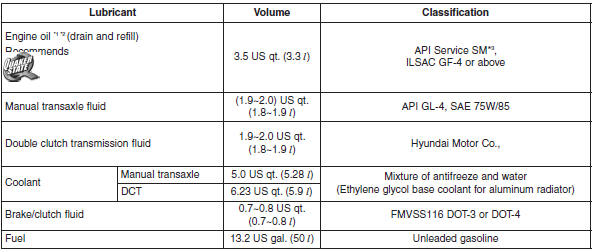 Hyundai Veloster: Recommended lubricants and capacities
Hyundai Veloster 2011-2017 Owner's Manual / Specifications, Consumer information, Reporting safety defects / Recommended lubricants and capacities
Hyundai Veloster: Recommended lubricants and capacities
Hyundai Veloster 2011-2017 Owner's Manual / Specifications, Consumer information, Reporting safety defects / Recommended lubricants and capacities
To help achieve proper engine and powertrain performance and durability, use only lubricants of the proper quality. The correct lubricants also help promote engine efficiency that results in improved fuel economy.
These lubricants and fluids are recommended for use in your vehicle.

*1 Refer to the recommended SAE viscosity numbers on the next page.
*2 Engine
oils labeled Energy Conserving Oil are now available. Along with other additional
benefits, they contribute to fuel economy by reducing the amount of fuel necessary
to overcome engine friction. Often, these improvements are difficult to measure
in everyday driving, but in a year’s time, they can offer significant cost and energy
savings.
*3 If the API service SM engine oil is not available in your country,
you are able to use API service SL.
Recommended SAE viscosity number
CAUTION
Always be sure to clean the area around any filler plug, drain plug, or dipstick before checking or draining any lubricant. This is especially important in dusty or sandy areas and when the vehicle is used on unpaved roads. Cleaning the plug and dipstick areas will prevent dirt and grit from entering the engine and other mechanisms that could be damaged.
Engine oil viscosity (thickness) has an effect on fuel economy and cold weather operating (engine start and engine oil flowability). Lower viscosity engine oils can provide better fuel economy and cold weather performance, however, higher viscosity engine oils are required for satisfactory lubrication in hot weather. Using oils of any viscosity other than those recommended could result in engine damage.
When choosing an oil, consider the range of temperature your vehicle will be operated in before the next oil change. Proceed to select the recommended oil viscosity from the chart.

*1. For better fuel economy, it is recommended to use the engine oil of a viscosity grade SAE 5W-20 (API SM / ILSAC GF-4). However, if the engine oil is not available in your country, select the proper engine oil using the engine oil viscosity chart.
 Capacity/weight
Capacity/weight
M/T : Manual transaxle A/T : Automatic transaxle DCT : Double clutch transmission ...
 Vehicle identification number (VIN)
Vehicle identification number (VIN)
The vehicle identification number (VIN) is the number used in registering your
car and in all legal matters pertaining to its ownership, etc.
The number is punched on the floor under the front pa ...
See also:
Winter driving
More severe weather conditions of winter result in greater wear and other problems.
To minimize winter driving problem, you should follow these suggestions:
Snowy or icy conditions
To drive your ...
Positive Crankcase Ventilation (PCV) Valve. Repair procedures
Removal
1.
Disconnect the vapor hose (A).
2.
Remove the PCV valve (B).
Inspection
1.
Insert a thin ...
Input Speed Sensor 2 > Repair procedures
Inspection
Refer to DTC code "P2765, P2766" Input Shaft Speed Sensor.
Removal
1.
Remove the under cover.
2.
Disconnect the inp ...
Categories
- Hyundai Veloster Manuals Home
- Hyundai Veloster 2010-2017 Owner's Manual
- Hyundai Veloster 2010-2017 Service Manual
